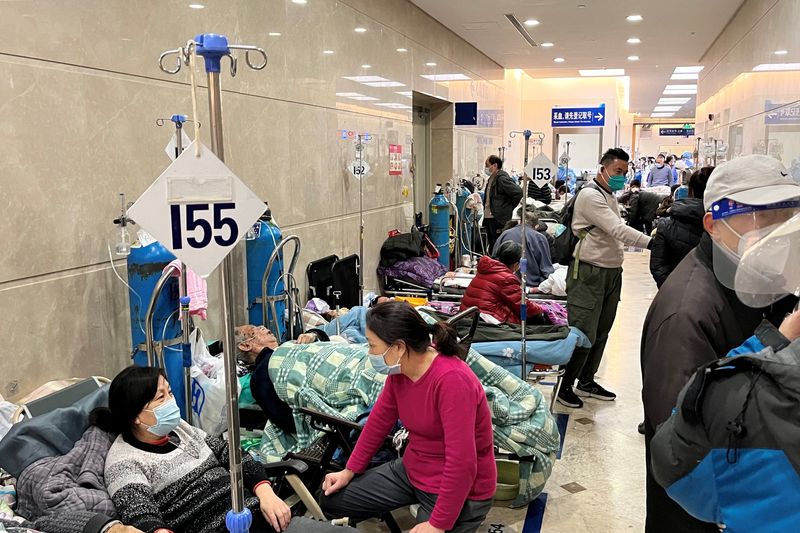Chinese media hide truth about COVID incidence statistics
2023.01.03 13:50

Chinese media hide truth about COVID incidence statistics
Budrigannews.com – China’s state media downplayed the seriousness of an uptick in COVID-19 infections ahead of a Tuesday presentation by its scientists to the World Health Organization. The organization was hoping for a “detailed discussion” on the virus’s evolution.
The accuracy of China’s case and mortality data, as well as China’s abrupt U-turn on COVID controls on December 7, have come under increasing scrutiny at home and abroad.
China’s foreign ministry said that some countries’ restrictions on travel entry were “simply unreasonable” and “lacked scientific basis.”
Mao Ning, a Beijing-based spokeswoman for the foreign ministry, told reporters, “We are willing to improve communication with the world.”
“However, we will take corresponding measures in various situations according to the principle of reciprocity, and we are firmly opposed to attempts to manipulate the epidemic prevention and control measures for political purposes.”
The World Health Organization (WHO) has urged Chinese health officials to share specific, up-to-date information on the outbreak frequently. At a technical advisory group meeting on Tuesday, the global body has invited Chinese scientists to present comprehensive data on viral sequencing. It has also requested that China share information on vaccinations, deaths, and hospitalizations.
Protests that had marked the strongest show of public defiance during President Xi Jinping’s decade in power and had coincided with the economy’s slowest growth in nearly half a century prompted China to abandon its “zero-COVID” policy.
Funeral homes have reported an increase in demand for their services as the virus spreads unchecked, and international health experts anticipate at least one million deaths in China this year.
China reported three new COVID deaths on Monday, bringing the total number of reported deaths from the pandemic to 5,253.
Chinese experts were quoted by the official Communist Party newspaper, People’s Daily, on Tuesday as saying that the virus’s illness was relatively mild for the majority of people.
According to Tong Zhaohui, vice president of the Beijing Chaoyang Hospital, “severe and critical illnesses account for 3% to 4% of infected patients currently admitted to designated hospitals in Beijing,” the newspaper.
According to Kang Yan, the head of Sichuan University’s West China Tianfu Hospital, 46 patients have been admitted to intensive care units in the past three weeks, or about 1% of all symptomatic infections.
A witness told Reuters that on Tuesday, the emergency room at the Zhongshan Hospital in Shanghai was crowded with patients.
While dozens of people waited in line around them to see a doctor, some were receiving IV treatment in beds in the corridor. It was unknown how many people had COVID.
A WHO spokesperson stated that a “detailed discussion” was anticipated regarding circulating variants worldwide and in China, with Chinese scientists expected to present.
Tuesday’s committee meeting included two prominent scientists who stated that they would seek a “more realistic picture” of the situation in China. After the private meeting was over, they stopped talking about it.
The WHO spokesperson went on to say that the organization would communicate later, probably during a news briefing on Wednesday.
However, some experts questioned Beijing’s openness.
Alfred Wu, an associate professor at the National University of Singapore’s Lee Kuan Yew School of Public Policy, stated, “I don’t think China will be very sincere in disclosing information.”
“They would rather just keep it to themselves, or else they would claim that nothing new occurred.” My own perception is that we could infer that there is nothing new; however, the issue of China’s transparency remains constant.
Travelers from China will be subjected to COVID testing in the United States, France, Italy, and other countries, and Belgium has stated that it will test the wastewater from planes for new variants.
On Wednesday, health officials from the European Union will meet to discuss a coordinated response.
On January 8, China will no longer require travelers entering the country to undergo quarantine. However, it will still require a test before departure.
Concerns about the near-term outlook for China’s second-largest economy grow as workers and customers get sick, which causes volatility in global financial markets.
China has received free COVID-19 vaccines from the European Union in response to rising infection concerns.
An EU spokesperson stated that Beijing has not yet responded to the offer. However, the move comes after Germany shipped 11,500 BioNTech COVID shots to China last month for use by German citizens there.
China has up until this point demanded utilizing just Chinese-made antibodies, which are viewed as less successful than Western ones in light of mRNA innovation.
China’s factory activity decreased last month, according to a survey released on Tuesday.
90% of Foxconn’s initial plans included December shipments from the company’s Zhengzhou iPhone plant, which were disrupted by worker departures and unrest amid a COVID outbreak.
According to Kristalina Georgieva, the head of the International Monetary Fund, a “bushfire” of infections in China in the coming months is likely to hurt the country’s economy this year and lower global growth.
Analysts at Capital Economics issued the following warning: “China is entering the most dangerous weeks of the pandemic.”
The Service of Culture and The travel industry said the 52.71 million homegrown outings during the New Year occasion produced 26.52 billion yuan ($3.84 billion), up 4% year-on-year however were exclusively around 35% of the last pre-pandemic year in 2019.
The major Lunar New Year holiday, which falls late this month, is anticipated to have a higher incidence of infections, according to some experts.
More Bad weather returns to U. S. storm and tornado








